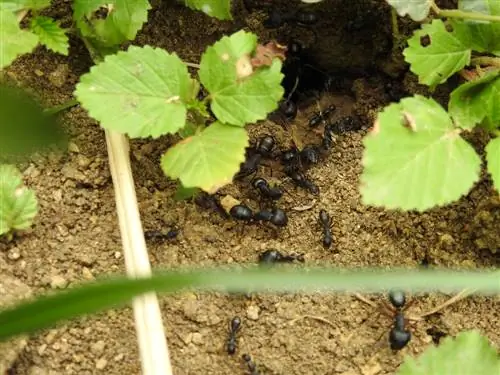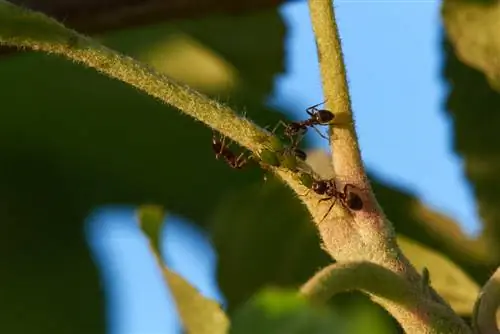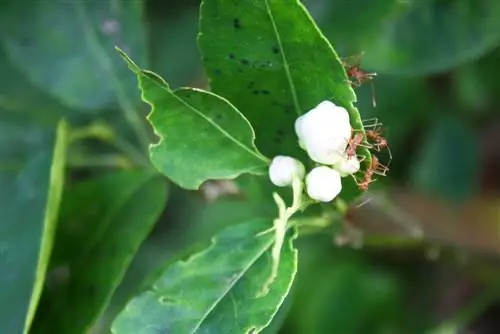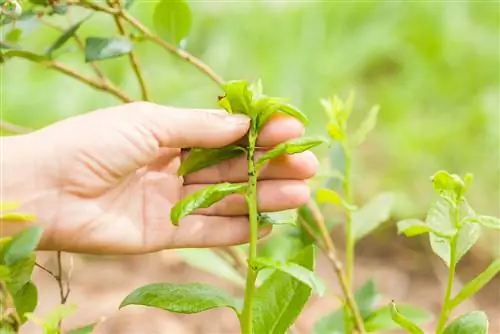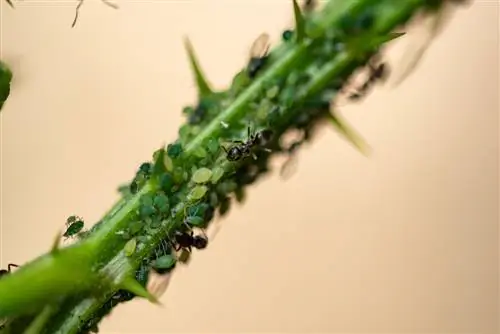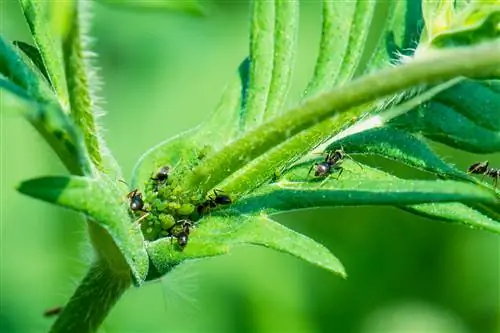- Author admin [email protected].
- Public 2023-12-16 16:46.
- Last modified 2025-01-23 11:22.
Ants are better than their reputation because they take on important functions. If they become a nuisance, goodwill is lost. But mass gatherings of ants have a special reason. It is important to uncover this because this is the only way improvement can occur.

How can you effectively get rid of ants in the garden?
Ants in the garden are useful helpers that remove waste and fight pests. If they become a nuisance, disturbances such as frequent relocation or controlling the food source such as aphids or root lice can help. Chemical control is not recommended as this disrupts the natural balance.
Garden habitat
Ants turn out to be true survivors because they populate a wide variety of habitats on earth. They survive temperatures down to minus 28 degrees Celsius without any problems and endure heat waves of 50 degrees. The insects are found in forests, bushes and fields. They like both shaded and moist habitats as well as dry and warm open areas. The garden also offers attractive conditions, but too many ants in the garden are usually perceived as a nuisance.
Why do ants come to the garden?
The cause of ant colonies in the garden lies in the optimal living environment. Species that settle in the garden prefer gaping forms of vegetation with access to the substrate. Forest-dwelling ants often migrate into the garden from neighboring forests. Ants that specialize in wood find optimal habitats in pristine gardens with old trees. Lice infestation on cultivated plants is often responsible for the establishment of an ant colony.
Be happy when ants have chosen your garden as their habitat. This shows that you have an attractive and diverse garden.
Useful or harmful?

Ants make an important contribution to our ecosystem
Whether ants in the garden are good or bad varies depending on the individual case. In principle, colony-forming insects take on important tasks in the ecosystem. They help ensure that balance can be established in nature. They remove waste and destroy dead animals.
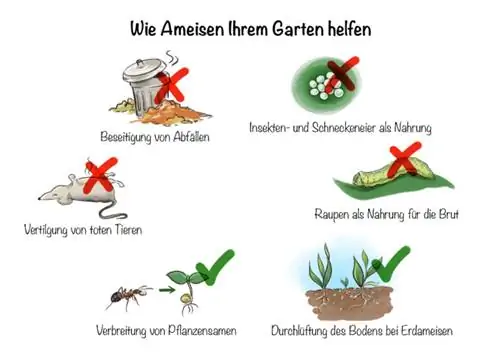
Ants feed on insect or snail eggs and drag caterpillars to their nest to care for the brood. They are also important seed dispersers and promote the survival of various plants. Earth-dwelling ant species ensure that the soil is aerated. Through their activities they counteract soil compaction. This aspect is also advantageous in the garden.
Ants in the food chain:
- Green Woodpecker: eats between 3,000 and 5,000 ants per day
- Antlions: Larvae have specialized in hunting ants
- Predator bugs: imitate pheromones and prey on ants on specially created ant trails

What damage do ants do in the garden?
The insects are not directly harmful to cultivated plants. If there is an ant nest in the bed, the tunnels in the substrate can negatively affect plant growth. Earth-dwelling ants feed on the honeydew of root lice, which are responsible for direct damage to plants. Mounds of earth and sand that form on the lawn or between paving slabs are unsightly.
Excursus
Functions of the mouthparts
The ants' mouthparts are composed of upper and lower lips, between which paired upper and lower jaws are formed. These tools belong to the chewing-biting type, with the upper jaws taking on a variety of functions. Ants not only use them to get food, but also defend themselves with their mouthparts. They use it to grab their prey and, in case of danger, carry the brood to a safe place.
Wintering
Ants differ from many other insects because they overwinter in different stages. Not only mated young queens but also larvae and workers retreat to their protected nest for the winter break. Wood ants are an exception because these species overwinter without breeding. Knot or garden ants can overwinter with or without larvae. For this reason, the ants do not disappear from the garden after one summer.
What species live in the garden
There are species of different genera that are also often found in the garden. Ants live in every garden, even if they are not noticed at first glance. The majority lead a life in secret. Flying ants often draw attention to the fact that the garden is being colonized by insects.
Path ants
The genus Lasius contains around 100 species, many of which are widespread in Central Europe. The species are rather small ants that feed largely on the excretions of aphids. They place fewer demands on their environment than wood ants. They mainly include brown or red ants, but black ants are also often present.
| Type | populated | Food | color | |
|---|---|---|---|---|
| Brown ant | Wood Dwellers | rotten wood | Honeydew from aphids | distinctive two-tone |
| Black garden ant | Earth Dwellers | Vacities under stones, lawns and beds | Honeydew from root lice | dark brown to black, silvery hair |
| Shiny Black Carpenter Ant | Wood Dwellers | rotten wood | Honeydew from aphids | deep black, shiny |
| Yellow meadow ant | Earth Dwellers | large lawns and beds | Honeydew from root lice | light yellow to brown-yellow |
| Two-colored garden ant | cavity dwellers | Dead wood, cavities under stones | dead insects, honeydew | red-yellow to red-brown and dark brown |
Forest ants
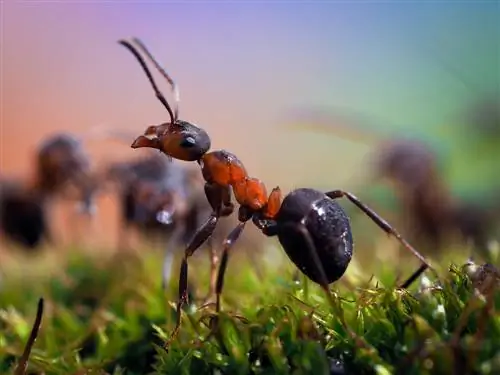
Forest ants are a large type of ant
This genus includes large ants that reach a body length of ten millimeters. The species build nests in the ground and in hills and prefer to live in forests. Formica species are omnivores and keep the forest floor clean. Mound-building forest ants enjoy special protection. Numerous species are endangered and are on the red list. The red wood ant can also settle in the garden if it is in the immediate vicinity of a forest.
The red wood ant likes this:
- sunlit areas on tree edges
- Insects, larvae, caterpillars and arachnids as well as carcasses and honeydew
- rotten tree stumps
Knot Ants
Ants of the genus Myrmica are medium-sized and build their nests in both dead wood and substrate. A common species in the garden is the red garden ant, which prefers moist conditions. It colonizes moss-covered lawns that grow higher. Their nests can be recognized as piles of soil on the edges of lawns or in the middle of the area. The insects are strikingly brownish-red in color.
Special features:
- aggressive behavior in case of nest disturbance
- group together to form ant clusters during floods
- have a poisonous stinger
Fire ants
The only species considered native north of the Alps is the yellow thief ant. It prefers warm locations with flat soil. The species builds its nests in sandy subsoil with dry conditions and sparse vegetation. Dry grass and rocky soils offer optimal conditions. In central and southern Germany, where the species is more common due to the favorable climate, yellow ants can also occur in urban settlement areas. You are a rather rare guest in the garden
Carpenter ants
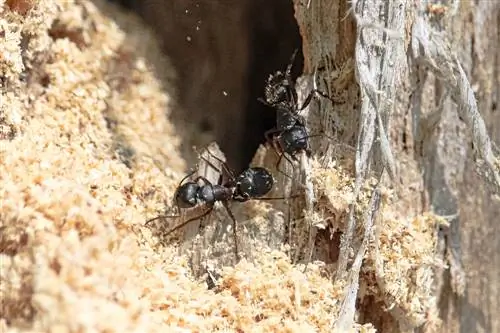
Carpenter ants colonize old wood, in rare cases also wooden beams
Black and brown-black carpenter ants are the largest species in Central Europe. They are dark colored and grow up to 18 millimeters long. The species are tree dwellers and colonize dead wood. In rare cases, the species can be observed in gardens that provide old fruit trees or rotten fence posts as habitats.
Fighting ants?
An intact garden is always colonized by ants. To maintain ant-free gardens, you would have to use poison. As a result, not only does the ant population suffer, but your he alth and the natural balance in the garden are also massively affected. If you fight or even destroy the ant colony, the symptoms will disappear for a short time. The cause remains.
Why fighting is pointless
Ants are territorial. Once they have found a territory, they defend it against other ant colonies and young ants. In the turf wars, the defenders kill immigrant ants and eat them. As soon as you interfere with these processes, the natural cycle is disrupted. The end of a colony means a new beginning for the next colony. If a burrow has been abandoned, after a short time new ants will migrate and colonize the garden.
Unsuitable home remedies
Baking soda and vinegar are effective under certain conditions. However, the funds have no place in the garden. The soil absorbs the substances faster than they affect ants. Coffee is also a common remedy for scaring away ants. This seems to work differently and is probably based on the scent. If you sprinkle particularly strong-smelling coffee grounds directly onto the ant nest, it can have a deterrent effect. However, the aromas evaporate quickly and the effect is lost.
Tip
You can prevent ant trails with a thick trail of cinnamon. The insects are confused by the intense aroma.
Tips for repelling and prevention
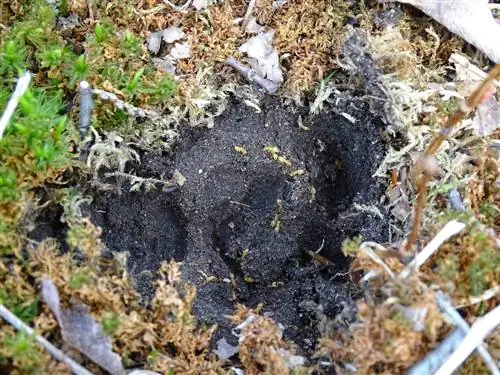
If ants feel disturbed, they move
Ants can be repelled completely naturally and without poison if you have a little patience. The measures are effective as long as you use them regularly. If necessary, use several methods, as not all ant species react equally well to the disturbances.
Systematic disorder
Ants like consistent conditions. If their nests are disturbed, the brood is in danger. The insects react to this by relocating their brood. If you have discovered a nest in the bed, you can press the soil firmly every day or poke it into the soil with a stick. As a result, the passages are filled up and the ants look for a new territory when there are constant disturbances.
Floods
Many terrestrial ants depend on moist conditions. However, they cannot raise brood in permanently wet soil. Flooding the burrows helps scare some species away. However, many ants cope well with heavy rain and are unimpressed by this measure.
Tip
You can use your aversion to moisture to relocate earth-dwelling ants. The flowerpot trick only works for these species after heavy rain.
Fighting food sources

Ants like to settle where there are aphids
Ants settle where there is enough food available. Both terrestrial and above-ground ants often feed on honeydew. If you find a nest in the bed or on the lawn, the plants are most likely affected by root lice. You can often find above-ground nests near plants where aphids live. To get rid of ants, you should fight the cause of their appearance:
- Water off aphids
- Fight root lice with tansy broth
- Strengthen plants with nettle manure
Unattractive habitats
Garden paths should be designed so that they appear unattractive to ants. Bas alt chippings are better suited to the substrate than paving sand. Seal joints with synthetic resin-based paving mortar (€19.00 on Amazon). There are good products that are permeable to water and effectively suppress ants and weeds.
Frequently asked questions
Can ants cause damage in the garden?
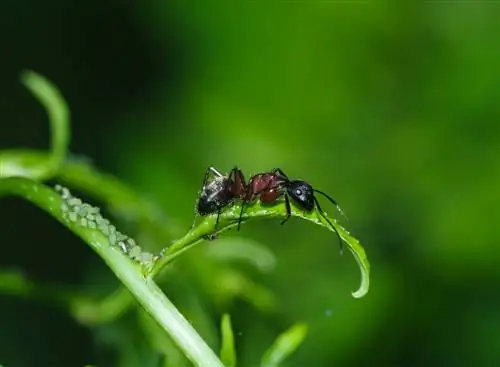
Ants do no damage to plants; they just milk aphids
Ants in beds and lawns do not cause any damage. But they show that something is wrong with the plants. Wherever ants appear, lice are not far away. Earth-dwelling species feed on the honeydew that root lice secrete. Aboveground ants often target the secretions of aphids. Instead of fighting the ants, you should deprive them of their food source and eliminate the lice infestation.
What to do against ants in the garden?
Coffee grounds are a natural remedy that effectively repels ants. However, the method does not always work because the coffee aroma wears off quickly and not all types react equally well to the substance. If the nest in the bed is disturbing, a massive disturbance can promise help. Poke the soil regularly with a stick until the ants find alternative quarters. Avoid eliminating ants. The insects are part of the ecosystem and cannot be eradicated in the garden.
What are ants looking for in the garden?
There are different species of ants that come to the garden for different reasons. Wood ants stray into human habitat if the forest is in the immediate vicinity. Many ants find optimal feeding conditions in gardens because cultivated plants are often infested with lice. Lawns provide good habitat conditions for ants that live underground. They appreciate the moist environment between patchy vegetation.
Why shouldn't ants be controlled?
Insects are an important part of the ecosystem. It doesn't matter whether it is a garden or a forest. Ants cause dead organic material to decompose. They clear the ground and aerate the substrate by digging tunnels. Ants are an important source of food for numerous living creatures. They are eaten by woodpeckers, predatory bugs or antlions.
Are there plants that attract ants?
There are tropical plants that have specialized in an interaction with ants. They provide insects with food and a habitat. In return, ants protect the plants from predators. Such a symbiosis can also be observed with cherry laurel. The tree has two glands on each leaf stalk that release a sugary sap. When production is in full swing in spring, the trees are overrun with ants. These protect their food suppliers by driving away plant pests.
How do ants hibernate?
Dwindling light, falling temperatures and food shortages force ants to hibernate. In order to survive the freezing temperatures, they have to defecate. The loss of fluid causes the remaining body fluids to thicken and frostbite is prevented. Many species of ants hibernate in different stages. Both larvae, workers and queens spend the winter in the protection of the nest. Only forest ants overwinter as adult insects.

